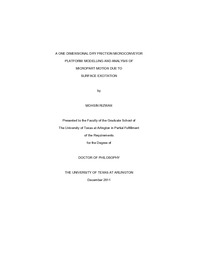
ATTENTION: The works hosted here are being migrated to a new repository that will consolidate resources, improve discoverability, and better show UTA's research impact on the global community. We will update authors as the migration progresses. Please see MavMatrix for more information.
Show simple item record
| dc.contributor.author | Rizwan, Mohsin | en_US |
| dc.date.accessioned | 2014-03-10T21:17:22Z | |
| dc.date.available | 2014-03-10T21:17:22Z | |
| dc.date.issued | 2014-03-10 | |
| dc.date.submitted | January 2011 | en_US |
| dc.identifier.other | DISS-11519 | en_US |
| dc.identifier.uri | http://hdl.handle.net/10106/24042 | |
| dc.description.abstract | Many approaches are used for micropart manipulation ranging from individual pick and place to manipulation through a workcell comprising of arrays of actuators. Existing approaches provide discrete actuation and have limitations on the lower bound on the size of the micropart to be handled. In this research, the active surface concept for non-contact micropart manipulation is investigated. The active surface deformation is generated by a set of controlled microactuators and provides for continuous micromanipulation while alleviating limitations of existing approaches. The drastic increase of surface area to volume ratio from macroscale to microscale requires the consideration of surface forces (such as van der Waals and Casimir) in any dynamic model for micropart motion. In this research, the dynamics of micropart (approximate dimensions of 100 um) on a flexible surface is developed accommodating this shift of dominance from body to surface forces. The dynamic bidirectional effects of the nanoscale surface roughness and microscale forces on each other are analysed and studied in a dynamic model to assess the friction force between the micropart and carrier surface based on augmenting the Kogut-Etsion friction model. The developed highly nonlinear dynamic model is then applied to study the motion of a micropart on a carrier surface under controlled deformation due to an attached microactuator. The effects of the various system parameters on the controlled micropart translocation are studied where is found that there are ranges in which translocation takes place or that the micropart becomes airborn and detaches from the carrier surface. The developed model is expanded and applied for an array of microactuators for the realization of a continuous microconveyor platform in a dry friction environment through parametric studies and constrained optimization approach indicating that a microconveyor platform could be realized based on the proposed approach and model. | en_US |
| dc.description.sponsorship | Shiakolas, Panayiotis S. | en_US |
| dc.language.iso | en | en_US |
| dc.publisher | Mechanical Engineering | en_US |
| dc.title | A One Dimensional Dry Friction Microconveyor Platform: Modelling And Analysis Of Micropart Motion Due To Surface Excitation | en_US |
| dc.type | Ph.D. | en_US |
| dc.contributor.committeeChair | Shiakolas, Panayiotis S. | en_US |
| dc.degree.department | Mechanical Engineering | en_US |
| dc.degree.discipline | Mechanical Engineering | en_US |
| dc.degree.grantor | University of Texas at Arlington | en_US |
| dc.degree.level | doctoral | en_US |
| dc.degree.name | Ph.D. | en_US |
Files in this item
- Name:
- Rizwan_uta_2502D_11519.pdf
- Size:
- 10.95Mb
- Format:
- PDF
This item appears in the following Collection(s)
Show simple item record


